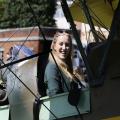
THE Ashmolean’s No Offence: Exploring LGBTQ+ Histories exhibition is a tour-de-force of global queer history.
Based on the pioneering work of Richard Parkinson, professor of Egyptology at Oxford and author of A Little Gay History, the exhibition traverses epochs and continents, deftly showing the numerous ways in which LGBTQ+ lives and loves have been expressed across cultures and throughout history.
But here in Oxford we do not have to look elsewhere to appreciate LGBTQ+ history and heritage. Our great city has been a hub of queer life and culture for centuries.
Oxford can trace its queer roots as far back as 1394. For five weeks in the late summer of that year, a transvestite prostitute named John Rykener worked in the city as an embroideress under the name of Eleanor. Later, Rykener confessed to police interrogators that during his stay here he had often ‘practiced the abominable vice’ with three scholars.
Stories such as this are integral to the history of Oxford and both its universities, although this is not always immediately apparent unless the history is known.
Many may be aware that Oscar Wilde attended Magdalen College during the 1870s, and that Evelyn Waugh’s classic novel Brideshead Revisited (1945) was founded on his undergraduate life at Hertford College during the early 1920s, but the full depth and breadth of LGBTQ+ experiences in the city that Wilde called ‘the capital of romance’ is only now being appreciated.
My new app-based city trail produced to coincide with the Ashmolean’s No Offence exhibition, foregrounds just some of the stories which makes Oxford one of the world’s most extraordinary queer localities.
It forms part of Oxford Alternative Stories, hosted by the Oxford Research Centre in the Humanities (TORCH), which shares stories, voices, and research which are too often unheard.
My favourite story concerns The Shooting Stars, one of Oxford’s first intercollegiate drama societies, active in the 1860s. This was a time before women were admitted as students into the University and so the male undergraduates had to play all the parts, some revelling in playing female roles both on and off stage.
In 1870, a student of Oriel College, Martin Luther Cumming, became embroiled in a great London scandal (the infamous ‘Fanny and Stella’ affair). Drama at Oxford was declared to be ‘a cloke for vice’ and, in consequence, all theatrical productions were banned for a decade.
Women were only allowed to matriculate at Oxford in 1920. Since that time, however, many female alumni have played significant roles in shaping modern LGBTQ+ life and culture. They include Labour Party politician Angela Eagle MP; Stonewall CEO Ruth Hunt; award-winning crime writer Val McDermid; and author and journalist Jeanette Winterson.
The new trail tells the story of novelist Mary Renault who was educated at St Hugh's College, receiving a degree in English in 1928 and thereafter training as a nurse at the Radcliffe Infirmary. During her training, she met Julie Mullard, a younger but more senior trainee nurse with whom Renault established a life-long partnership.
Celebrated travel writer Jan Morris attended Christ Church (as James Morris) between 1949 and 1951, but her long association with Oxford began in 1938 when she attended the College’s Cathedral Choir School. ‘Oxford made me’, she wrote in her 1974 memoir Conundrum.
Others were not so fortunate and fell foul of the draconian cultural regime which blighted the lives of so many Britons through the darkest days of LGBTQ+ repression. For example, during the 1950s many students identified as homosexual were sent to local hospitals for medical treatment.
The 1970s began to see profound changes in attitudes towards LGBTQ+ people and Oxford’s residents and students have long worked together at the forefront of equality campaigns.
The University’s famous GaySoc (now LGBTQ+ Society) was established in 1975.
Oxford’s first gay venue, the Stage Club, was situated on the corner of George Street and Victoria Court (on the floor above where Bella Italia is today). The venue traded as the Clarendon Tea Rooms by day, transforming into ‘70s gay disco glory by night.
Had space permitted, many more stories could have been included in the new trail. For example, Project October, set up in 1986 to attempt to rectify a pressing need for local facilities for the city’s LGBTQ+ residents, resulted in the setting up of the Oxford Lesbian and Gay Community Centre at Northgate Hall on St Michael’s Street. Opened by Sir Ian McKellen in 1991, the venue was one of the only community centres of its kind in the country until its sad and much-lamented closure in 2005.
Notwithstanding, it was in 2005 that National Student Pride was founded at Oxford Brookes University by Tom Guy, an interior architecture student at the time and now the organisation’s president.
Recovering these stories—and there are many, many more—show that Oxford has played an integral part in British LGBTQ+ history in diverse ways.
By foregrounding just some of the people, places, and objects associated with over six centuries of local LGBTQ+ history, the new trail spotlights Oxford as a welcoming place for residents, students, and visitors of all genders and sexualities and showcases the city as a world-class centre for improving our awareness of history and heritage in all its diversity.



Comments: Our rules
We want our comments to be a lively and valuable part of our community - a place where readers can debate and engage with the most important local issues. The ability to comment on our stories is a privilege, not a right, however, and that privilege may be withdrawn if it is abused or misused.
Please report any comments that break our rules.
Read the rules hereLast Updated:
Report this comment Cancel